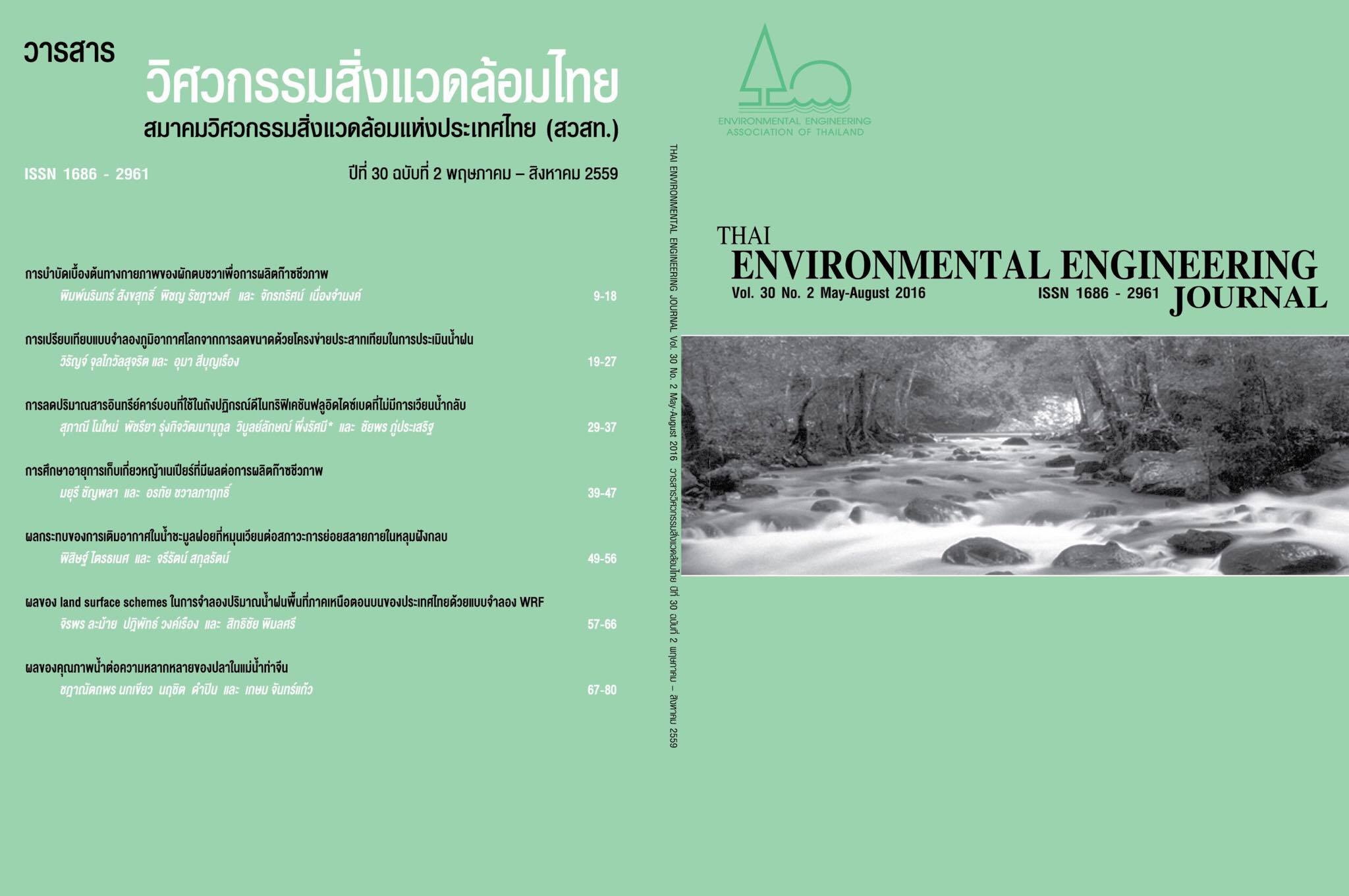Effect of Water Quality to Biodiversity of Fish in the Tha Chin River
Main Article Content
Abstract
The study of water quality on both species diversity and distribution of fish in Tha chin river starting from Pak Khlong Makham Thao, Wat Sing District Chainat province to Nakhon Pathom province in the rainy season (November 2013) and dry season (January 2014). Samples were collected in various study sites based on differences of land use where consist of agriculture, community and industry. Sample collecting was done in two sections
(7 stations) which in the upper part (3 stations) and the middle part (4 stations) of Tha Chin river. In The upper part of the river, agriculture is the major area; whereas land use in the middle part is agriculture at the most and followed by community mixed with some small industries. Local fishing tools including fishing nets, traps were used for sampling collection. The environmental factors including quality of water, phytoplankton, zooplankton and benthos were also investigated. It was found that there were 21 families (61 species) of which the majority of fishes (24 species) was Cyprinidae being 39.34% of total fish samples. Sixteen families (49 species) and sixteen families (44 species) were found at the upper and middle sections of the river respectively. The diversity index and evenness index was between 2.62-3.21 and 0.73-0.85 respectively. The quality of water in the upper stream was better than in the middle stream. The quality of water in the upper part of the river was suitable for the survival of fishes. High BOD value was observed in the middle part of the river which caused by the dense community producing high wastewater quantity. As a result the fish diversity index in the upper stream was higher than the middle stream, indicated water quality was appropriate for fish living. The result indicated that the relation between diversity index and water quality was in the same direction with DO but negative relation with BOD and nitrate.
Article Details
References
[2] Office of the National Environment Board. 2011. Tha Chin River Water Quality Report 2011. Division of Environmental Quality Standards. Ministry of Science and Technology Energy. (in Thai)
[3] Royal Irrigation Department. 2011. Sugar barge that sank in Chao Phraya River Ayutthaya. Division of Environmental Quality Standards. Office of National Environmental Board. (in Thai)
[4] Duangsawasdi, S. 1989. Study on species distribution and reproductive biology of fishes in the Tha Chin River. Inland Fisheries Resources Research and Development Institute. (in Thai)
[5] Patmanothai, A. 2015. Prevalence of Fish parasite from Tha-chin River after Flood Crisis 2011. Master of Science. Kasetsart University. (in Thai)
[6] Boonchoosri, W. 2015. Effects of Land Use Change on the Quantity and Nutrient of Sediment in Tha Chin River Basin. Master of Science. Kasetsart University. (in Thai)
[7] Smith, M.H. 1945. The Fresh-water Fishes of Siam, or Thailand. Smithsonian Institute United States National Museum. 622 pp.
[8] Rainboth WJ. 1996. Fishes of the Cambodian Mekong. Food and Agriculture Organization of the United Nations, Rome.
[9] Nelson, J.S. 1994. Fishes of the World. 3rd Ed. John Wiley & Sons, Inc, New York. 600 p.
[10] Ludwig, A.J. and J.F. Reynolds. 1986. Statistical Ecology. John Wiley and Sons Inc., New York. 337.
[11] Clarke, K.R. and R.M., Warwick. 1994. Change in Marine Community; an approach to statistic analysis and interpretation. Plymouth Marine Laboratory. Plymouth, UK. 144 pp.
[12] Phukhasawan, T. 1980. The development and management freshwater fishery resources. Department of Fisheries. (in Thai)
[13] Sukthai, R. 2015. Self Recovery Potential of Organic Substance Contamination from Point Source Along with Tha Chin Riverbanks. Master of Science. Kasetsart University. (in Thai)
[14] Charoenkhun, S. 2012. Self-Purification Capability of Tha Chin River to Accommodate the Deteriorated Qualitative Water of Crisis Floods 2011 in the Central After Moving to Bangkok for Safety flow to the Gulf of Thailand. Master of Science. Kasetsart University. (in Thai)
[15] Phanthanit, P. 2000. Spices Diversit of Fishes in the Chao Phraya River from Nakhon Sawan to Phra Nakron Sri Ayutthaya Province. Master of Science. Kasetsart University. (in Thai)
[16] Rukaewma, P. 2007. Species and Distribution of Fish Larvae in Maeklong Estuary, Samut Songkhram Province, Master of Science (Fisheries Science) in fisheries science. Department of Fisheries Biology. Kasetsart University. (in Thai)
[17] Sangkhapaitoon, S. 2008. Structure and Distribution of Fish Community in Kuan Kreng Peatswamp, Nakhon Si Thammarat Province. Inland Fisheries Resources Research and Development Institute. (in Thai)
[18] Sirirustananun, N. 2012. Species diversity of fishes in Padang reservoir, Sadeang district, Mueang Phetchabun; June – September 2012. Agricultural Management Faculty of Agricultural Technology. Phetchabun University. (in Thai)
[19] Suvarnaraksha, A. 2001. Fish Diversity of Chaing Dao wild life and sanctuary. Maejo university. (in Thai)
[20] Suvarnaraksha, A., Promya, J. and Chareonsiriwthana, A. 2010. Fish Diversity in Salween Watershed in Thai Water. Maejo University. (in Thai)
[21] Stacey, J.D. 1983. Patrtarchy and Soctahsi Revoluttontn Chma. University of California Press, Berkeley.
[22] Tudorancea, C., R.H. Green and J. Huebner. 1979. Structure Dynamics and Production of the Benthic Fauna in Lake Monutoba. Hydrobiologia.
[23] Phalee, A. 2006. Relationship between Water Quality and Fish Diversity in Intersection Zone Area between Kuang River and Ping River, Lamphun Province, 2005-2006. Master of Science(Biology). Kasetsart University. (in Thai)
[24] Hynes, H.B.N. 1970. The Ecology of Running Water. Liverpool, Liverpool University Press.
[25] Christian, W. 2001. Conservation of fish species diversity in navigable waterways. Landscape and Urban Planning.
[26] Heip, C. 1974. A new index measuring evenness. Journal of Marine Biological Association 54: 555-557.
[27] Zweig, D.R., J.D. Morton and M.M. Stewart. 1999. Source Water Quality for Aquaculture: A Guide for Assessment. Environmentally and Socially Sustainable Development, The World Bank, Washington, D. C.


